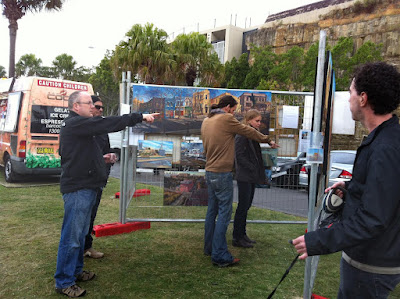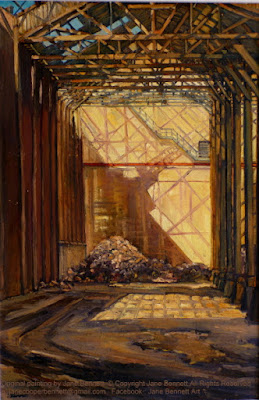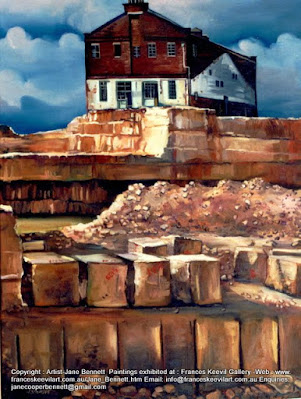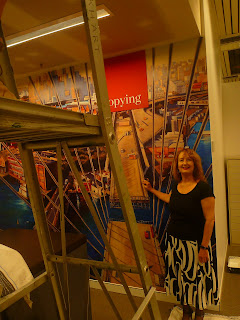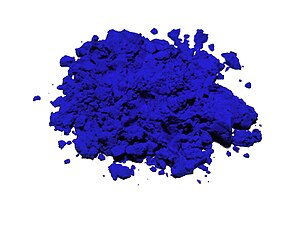
Half finished canvas on the easel
"The 'Terminus' versus the 'Pyrmont Point Hotel' "
2012 oil painting on canvas 31 x 61cm
Sold
Enquiries about similar paintings:
janecooperbennett@gmail.com
Last week I returned to a painting that I had started 2 years ago but had left half finished due to having to complete other projects.
I had painted the two hotels from this viewpoint on the corner of John and Harris Streets countless times before. I still had several canvases of the Terminus but I especially wanted to paint a panorama giving equal space to the Terminus and Pyrmont Point Hotels.
59 versus 61 Harris Street Pyrmont - the old versus the new Pyrmont, divided by the striding legs of the Anzac bridge looming over the towers of Jackson's Landing.

Half finished canvas on the easel
"The 'Terminus' versus the 'Pyrmont Point Hotel' "
2012 oil painting on canvas 31 x 61cm
Sold
Enquiries about similar paintings:
janecooperbennett@gmail.com
I had completed a similar canvas from this viewpoint about 2 years ago, but had sold it almost immediately to a local couple who had met each other at the Point Hotel.

Half finished canvas on the easel
"The 'Terminus' versus the 'Pyrmont Point Hotel' "
2012 oil painting on canvas 31 x 61cm
Sold
Enquiries about similar paintings:
janecooperbennett@gmail.com
In the first photo of the work in progress, the previous colour scheme of the "Pyrmont Point Hotel" from 2 years before is still visible. The strange faded plum tone reminded me of an over-ripe version of the once ubiquitous "Paddo pink" in the first wave of gentrification that spread all over the 1980s inner city. It clashed horribly with the dark crimson awning.
Now it is under new management, with a brand new colour scheme to mark the change. The walls are a more subdued and elegant pale yellow green, with awnings and window frames in chocolate. One effect of the new wall colour is to make the "ghost sign" of the hotel's original name the "Royal Pacific" more apparent.
Meanwhile the Terminus hasn't changed a bit.

Half finished canvas on the easel
"The 'Terminus' versus the 'Pyrmont Point Hotel' "
2012 oil painting on canvas 31 x 61cm
Sold
Enquiries about similar paintings:
janecooperbennett@gmail.com
I spent the first afternoon repainting the walls of the "Pyrmont Point Hotel" to the new colour. It probably would have been quicker and easier to just start a completely new canvas.
The practice of plein air painting often results in many half finished and potentially unfinishable canvases, so that you have to grit your teeth and accept it as an inevitable part of the process. So many elements are beyond the artist's control that plein air painting becomes hopelessly frustrating if you can't cope with "unfinished business".
I love being able to revive a canvas that I have had to turn face to the wall for weeks, months or even years.
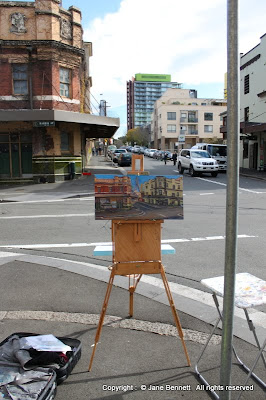
Half finished canvas on the easel
"The 'Terminus' versus the 'Pyrmont Point Hotel' "
2012 oil painting on canvas 31 x 61cm
Sold
Enquiries about similar paintings:
janecooperbennett@gmail.com
By the end of the first day, I had the basics blocked out and the canvas only needed the finishing touches.
And just as well.
When I delivered another work to the Frances Keevil Gallery, I discovered that a couple from Pyrmont were extremely interested in this painting. They had actually watched me while I was painting it!
Unfortunately they were due to leave Australia the next week.
I would have to complete the painting by Wednesday at the latest if it was going to be dry (well... dryish!) by Saturday, when the clients came in to the Frances Keevil Gallery to view it.
I don't think that they realized that it was an oil painting and they were cutting it a bit fine if it was to be finished, dry and ready to be delivered.
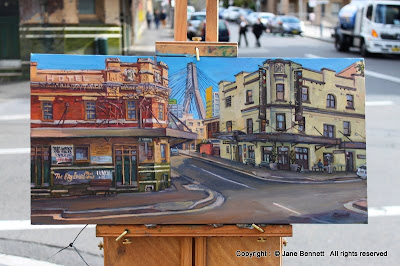
Half finished canvas on the easel
"The 'Terminus' versus the 'Pyrmont Point Hotel' "
2012 oil painting on canvas 31 x 61cm
Sold
Enquiries about similar paintings:
janecooperbennett@gmail.com
It was Tuesday.
And there were many distractions.I love chatting to people as I paint. I get to meet interesting people and learn a lot of fascinating things about the location.
But I was under a bit of time pressure and I must admit that I was worried.
The painting looks almost finished in this photo, but the final touches which can make or break a painting are very fiddly and it's perilous to rush them.
One of the most important of these was the "ghost sign" of the Pyrmont Point's previous incarnation as the Royal Pacific. Another vital detail was the light coming from the interior of the Pyrmont Point which contrasted with the dead heart of the Terminus.

The artist with local resident Van Le
with the nearly complete canvas
"The 'Terminus' versus the 'Pyrmont Point Hotel' "
2012 oil painting on canvas 31 x 61cm
Sold
Enquiries about similar paintings:
Tuesday seemed to be an extremely busy day on the corner of John and Harris St.
I became a bit of a tourist attraction. Here I am with Van Le, a local resident.

The artist with local resident
Francis Lee with the nearly complete canvas
"The 'Terminus' versus the 'Pyrmont Point Hotel' "
2012 oil painting on canvas 31 x 61cm
Sold
Enquiries about similar paintings:
janecooperbennett@gmail.com
And with Francis Lee, another local resident, who kindly took these pictures of me in action.

"The 'Terminus' versus the 'Pyrmont Point Hotel' "
2012 oil painting on canvas 31 x 61cm
Sold
Enquiries about similar paintings:
janecooperbennett@gmail.com
I needn't have worried.
The painting was completed.
And the couple loved it and bought it.
Apparently one of the pair had been covertly watching me paint the finishing touches on this canvas from a safe distance at the pub opposite.
I'm glad that I didn't know that at the time or I would have suffered stage fright.
I actually think that this painting turned out better than the one that I had painted 2 years before. Mind you, I've certainly had quite enough practice painting these pubs. The first time was about 30 years ago - doesn't time fly when you're having fun!
Also watching me were 2 photographers who were checking out the Terminus. They took a few photos of me (no makeup, covered in paint from head to foot, looking like a bag lady...oh well!) and chatted about the charms of urban decay as I desperately tried to finish my commission. Like many photographers, they seemed more interested in the freshly squeezed oil paint on my palette than the actual canvas. The process not the result.
Check out the photos they took of me and my painting here at the blog on their site.
Tristan Stefan Edouard Photography
For more information about the Terminus and Pyrmont Point Hotels see My Pyrmont page in this blog
Related posts
Looking over the overlooked-Urban decay in Pyrmont
To the Point
Wrong side of the tracks - Darling Island Bond and Free
Pretty vacant A Tale of two hotels - the Terminus and the Point
Pyrmont Paintings past and present
Paintings of Pink pubs - Painting the Jolly Frog Part 2





